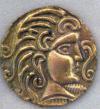Artificial Intelligence to Better Predict Severe Weather

Researchers have created AI algorithm to detect cloud formations that lead to storms
When forecasting weather, meteorologists use a number of models and data sources to track shapes and movements of clouds that could indicate severe storms. However, with increasingly expanding weather data sets and looming deadlines, it is nearly impossible for them to monitor all storm formations — especially smaller-scale ones — in real time.
Credit: NOAA / Wikimedia Commons
Now, there is a computer model that can help forecasters recognize potential severe storms more quickly and accurately, thanks to a team of researchers at Penn State, AccuWeather, Inc., and the University of Almería in Spain. They have developed a framework based on machine learning linear classifiers — a kind of artificial intelligence — that detects rotational movements in clouds from satellite images that might have otherwise gone unnoticed. This AI solution ran on the Bridges supercomputer at the Pittsburgh Supercomputing Center.
Steve Wistar, senior forensic meteorologist at AccuWeather, said that having this tool to point his eye toward potentially threatening formations could help him to make a better forecast.
“The very best forecasting incorporates as much data as possible,” he said. “There’s so much to take in, as the atmosphere is infinitely complex. By using the models and the data we have [in front of us], we’re taking a snapshot of the most complete look of the atmosphere.”
In their study, the researchers worked with Wistar and other AccuWeather meteorologists to analyze more than 50,000 historical U.S. weather satellite images. In them, experts identified and labeled the shape and motion of “comma-shaped” clouds. These cloud patterns are strongly associated with cyclone formations, which can lead to severe weather events including hail, thunderstorms, high winds and blizzards.
Then, using computer vision and machine learning techniques, the researchers taught computers to automatically recognize and detect comma-shaped clouds in satellite images. The computers can then assist experts by pointing out in real time where, in an ocean of data, could they focus their attention in order to detect the onset of severe weather.
“Because the comma-shaped cloud is a visual indicator of severe weather events, our scheme can help meteorologists forecast such events,” said Rachel Zheng, a doctoral student in the College of Information Sciences and Technology at Penn State and the main researcher on the project.
The researchers found that their method can effectively detect comma-shaped clouds with 99 percent accuracy, at an average of 40 seconds per prediction. It was also able to predict 64 percent of severe weather events, outperforming other existing severe-weather detection methods.
“Our method can capture most human-labeled, comma-shaped clouds,” said Zheng. “Moreover, our method can detect some comma-shaped clouds before they are fully formed, and our detections are sometimes earlier than human eye recognition.”
“The calling of our business is to save lives and protect property,” added Wistar. “The more advanced notice to people that would be affected by a storm, the better we’re providing that service. We’re trying to get the best information out as early as possible.”
This project enhances earlier work between AccuWeather and a College of IST research group led by professor James Wang, who is the dissertation adviser of Zheng.
“We recognized when our collaboration began [with AccuWeather in 2010] that a significant challenge facing meteorologists and climatologists was in making sense of the vast and continually increasing amount of data generated by Earth observation satellites, radars and sensor networks,” said Wang. “It is essential to have computerized systems analyze and learn from the data so we can provide timely and proper interpretation of the data in time-sensitive applications such as severe-weather forecasting.”
He added, “This research is an early attempt to show feasibility of artificial intelligence-based interpretation of weather-related visual information to the research community. More research to integrate this approach with existing numerical weather-prediction models and other simulation models will likely make the weather forecast more accurate and useful to people.”
Concluded Wistar, “The benefit [of this research] is calling the attention of a very busy forecaster to something that may have otherwise been overlooked.”
In addition to Zheng, Wang and Wistar, the research team included Yukun Chen, doctoral student in the College of IST; Jianbo Ye, former doctoral student in the College of IST and current applied scientist at Amazon Lab 126; Jia Li, professor of statistics in Penn State’s Eberly College of Science; Jose Piedra-Fernandez, collaborating faculty member at the University of Almería, and Michael Steinberg, senior vice president at AccuWeather, Inc.
The researchers’ work was supported in part by the National Science Foundation, the Amazon AWS Cloud Credits for Research Program, and the NVIDIA Corporation’s GPU Grant Program, and was published in the June 6, 2019, issue of IEEE Transactions on Geoscience and Remote Sensing.
Contacts and sources:
Jessica Hallman
Penn State
Citation: Detecting Comma-Shaped Clouds for Severe Weather Forecasting Using Shape and Motion.
Xinye Zheng, Jianbo Ye, Yukun Chen, Steve Wistar, Jia Li, Jose A. Piedra Fernandez, Michael A. Steinberg, James Z. Wang. IEEE Transactions on Geoscience and Remote Sensing, 2019; 57 (6): 3788 DOI: 10.1109/TGRS.2018.2887206
Source: http://www.ineffableisland.com/2019/07/artificial-intelligence-to-better.html
Anyone can join.
Anyone can contribute.
Anyone can become informed about their world.
"United We Stand" Click Here To Create Your Personal Citizen Journalist Account Today, Be Sure To Invite Your Friends.
Before It’s News® is a community of individuals who report on what’s going on around them, from all around the world. Anyone can join. Anyone can contribute. Anyone can become informed about their world. "United We Stand" Click Here To Create Your Personal Citizen Journalist Account Today, Be Sure To Invite Your Friends.
LION'S MANE PRODUCT
Try Our Lion’s Mane WHOLE MIND Nootropic Blend 60 Capsules
Mushrooms are having a moment. One fabulous fungus in particular, lion’s mane, may help improve memory, depression and anxiety symptoms. They are also an excellent source of nutrients that show promise as a therapy for dementia, and other neurodegenerative diseases. If you’re living with anxiety or depression, you may be curious about all the therapy options out there — including the natural ones.Our Lion’s Mane WHOLE MIND Nootropic Blend has been formulated to utilize the potency of Lion’s mane but also include the benefits of four other Highly Beneficial Mushrooms. Synergistically, they work together to Build your health through improving cognitive function and immunity regardless of your age. Our Nootropic not only improves your Cognitive Function and Activates your Immune System, but it benefits growth of Essential Gut Flora, further enhancing your Vitality.
Our Formula includes: Lion’s Mane Mushrooms which Increase Brain Power through nerve growth, lessen anxiety, reduce depression, and improve concentration. Its an excellent adaptogen, promotes sleep and improves immunity. Shiitake Mushrooms which Fight cancer cells and infectious disease, boost the immune system, promotes brain function, and serves as a source of B vitamins. Maitake Mushrooms which regulate blood sugar levels of diabetics, reduce hypertension and boosts the immune system. Reishi Mushrooms which Fight inflammation, liver disease, fatigue, tumor growth and cancer. They Improve skin disorders and soothes digestive problems, stomach ulcers and leaky gut syndrome. Chaga Mushrooms which have anti-aging effects, boost immune function, improve stamina and athletic performance, even act as a natural aphrodisiac, fighting diabetes and improving liver function. Try Our Lion’s Mane WHOLE MIND Nootropic Blend 60 Capsules Today. Be 100% Satisfied or Receive a Full Money Back Guarantee. Order Yours Today by Following This Link.








A true assessment would show the the obvious. Weather is A.I